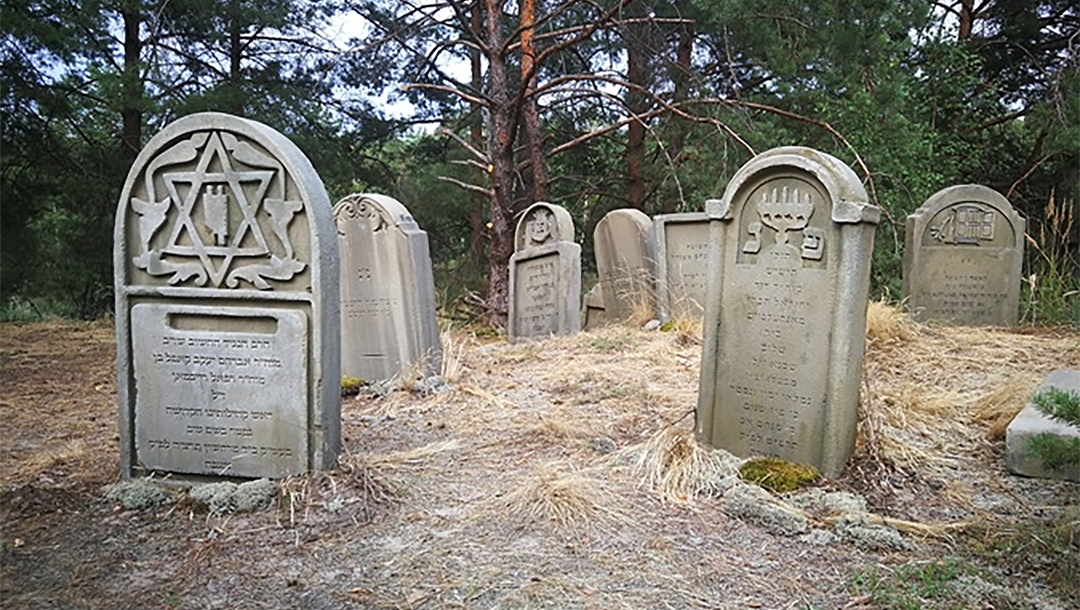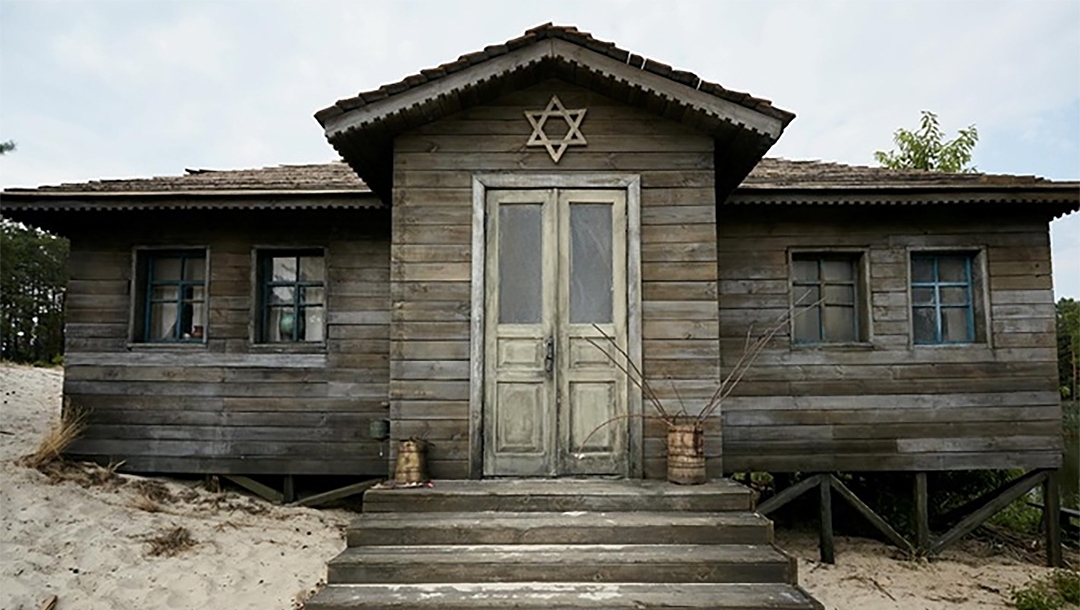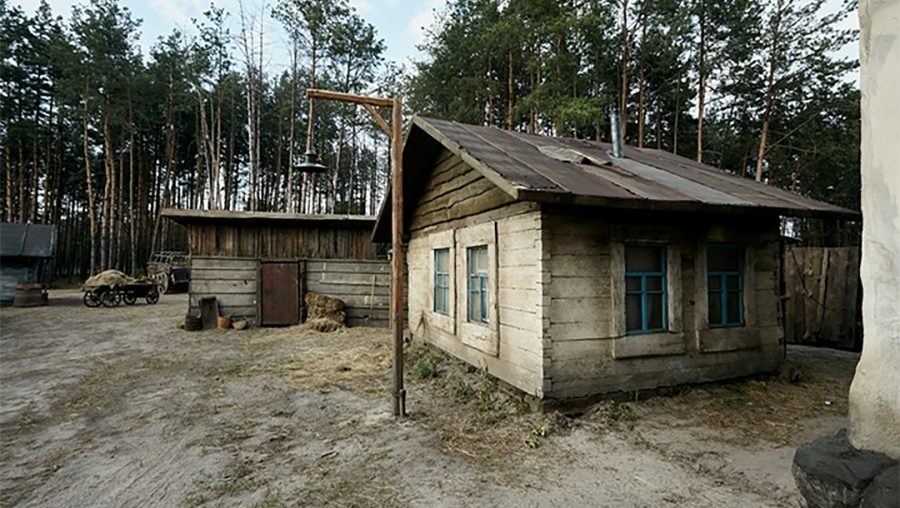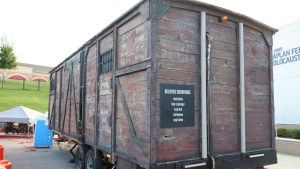Filmmakers constructed an acre-sized shtetl for a Ukrainian WWII film. Now they want to preserve it as a museum.
Published August 11, 2021
(JTA) — In the woods of northern Ukraine, construction workers have built an island in time: a shtetl.
That’s the Yiddish word for the type of old-fashioned Jewish towns that existed throughout Eastern Europe before the Holocaust.
This new shtetl, comprising 18 buildings on more than an acre of land near the lakeside town of Rovzhi, near Kyiv, was built this summer over 50 days as the set for a historical feature film titled “Shttl.” (The “e” is missing to underline emptiness, director Edie Walter, an Argentina-born filmmaker, told the Ukrainian news site KP).
ADVERTISEMENT
The film, a joint French-Ukrainian production, is unusual both for its budget of several million dollars — a massive investment in Ukraine’s ailing economy — and its treatment of a tragic and politically sensitive period in the history of Jews in Ukraine.
Scheduled to premiere next year, the movie even has some Hollywood star power in Saul Rubinek, a Canadian-Jewish actor who featured in the 1987 classic “Wall Street” alongside Michael Douglas and has had TV guest appearances on “Frasier,” “Curb Your Enthusiasm,” “Schitt’s Creek” and “The Marvelous Mrs. Maisel.” Rubinek also plays a heavily accented Jewish weapons expert in the Nazi hunter drama “Hunters” on Amazon.
“Shttl,” set in the summer of 1941, follows how the Nazi invasion of Ukraine devastated the lives of two Jewish newlyweds and their one-time shtetl community in Sokal, in Western Ukraine.
It’s a potential foray into a political landmine.
During that summer, especially in Western Ukraine, locals participated in the liquidation of area Jews, sometimes with remarkable cruelty. The country is now in the midst of a polarizing debate about the glorification of some of those perpetrators amid a surge of nationalism and antipathy toward Russia, which the Nazi collaborators were fighting during World War II.

The polystyrene headstones on the set of the film “Shttl,” a French-Ukrainian production about the Holocaust that is being filmed outside Kyiv, Ukraine in 2021. (KP/Star Media)
ADVERTISEMENT
President Vlodymyr Zelensky, who is Jewish, has expressed reservations about the practice of glorifying Nazi collaborators but has generally avoided confrontations over the issue with nationalists, who enjoy considerable popular support amid a simmering territorial conflict with Russia that began in 2014.
Following a march through Kyiv in May that featured Nazi symbols, Zelensky for the first time condemned the practice outright.
“We categorically condemn any manifestation of propaganda of totalitarian regimes, in particular the National Socialist, and attempts to revise the truth about World War II,” he said in a statement.
Reports this week in the Ukrainian media about the film have not addressed how the filmmakers intend to navigate these complicated issues. Both the film’s French and Ukrainian production companies have not responded to requests for comment.
Bringing a shtetl back to life was of paramount importance to Walter, he told KP.
“I want the viewers to walk in the alleyways along with the actors and feel everything,” he said.
Walter added that although the protagonists of the film are the Jewish couple, a non-Jewish Ukrainian character also has an important role as a close friend of the Jewish groom.
The actress portraying the bride, Anisia Stasevich, studied Yiddish for the role. She also studied with Eli Rosen, an actor who was raised in a Hasidic Jewish community in Brooklyn and was consulted by makers of the Netflix series “Unorthodox.”
Stasevich’s grandfather was a Jew from the Ukrainian city of Odessa who would “be happy to see me returning to the roots,” she told KP.
To lower costs, the producers bought old houses across Ukraine and scavenged them for parts to erect the set, production designer Ivan Levchenko told the news site. Doing so was cheaper than processing and aging fresh materials, he said. Some buildings were built of polystyrene, upon which artists drew fake facades. That was the solution as well for the headstones of the fake shtetl’s cemetery.

The facade of the school building on set. (KP/Star Media)
Other structures include a school, a large wooden structure with a Star of David on its gable, and a synagogue complete with massive wooden doors and an interior that took a crew of artists two weeks to paint.
The set has attracted attention in the Ukrainian media because of the unusual attempt to recreate an institution that had existed for centuries in Eastern Europe.
Only remnants of shtetls can be seen now in a handful of places, including Bershad, a sleepy town 160 miles south of Kyiv. The tiny synagogues, or shtiebels, have mostly remained intact there, although the interiors have been converted into shops and auto repair shops. But 50 Jews remain, maintaining a typical shtetl synagogue with board floors.
In Belarus, the city of Babruysk also boasts a well-preserved former shtetl, though most of its Jewish population of several hundred do not live there.
The best preserved shtetl today exists outside Europe in the town of Krasnaya Sloboda, in Azerbaijan, where several hundred Jews live with financial support from community members who left for Russia, Israel and beyond.
In other shtetls, structures have long been destroyed, taken apart or decayed and are now indistinguishable from their surrounding villages and towns.
The film’s production firm is working on turning the set into a museum and memorial monument for the hundreds of shtetls destroyed by the Nazis and their collaborators, KP reported.
“The main issue is to leave it in good hands,” Walter said.
—
The post Filmmakers constructed an acre-sized shtetl for a Ukrainian WWII film. Now they want to preserve it as a museum. appeared first on Jewish Telegraphic Agency.















